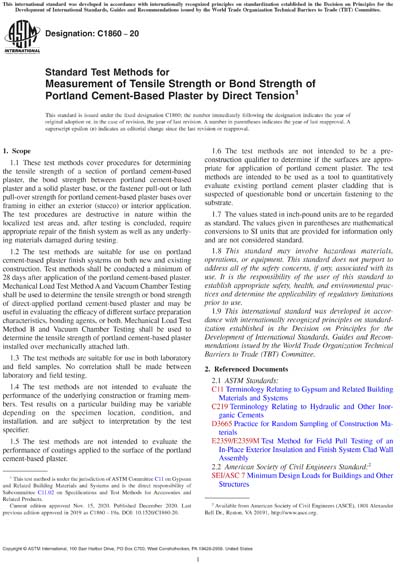Historical
ASTM C1860-20
Standard Test Methods for Measurement of Tensile Strength or Bond Strength of Portland Cement-Based Plaster by Direct Tension
1.1 These test methods cover procedures for determining the tensile strength of a section of portland cement-based plaster, the bond strength between portland cement-based plaster and a solid plaster base, or the fastener pull-out or lath pull-over strength for portland cement-based plaster bases over framing in either an exterior (stucco) or interior application. The test procedures are destructive in nature within the localized test areas and, after testing is concluded, require appropriate repair of the finish system as well as any underlying materials damaged during testing.
1.2 The test methods are suitable for use on portland cement-based plaster finish systems on both new and existing construction. Test methods shall be conducted a minimum of 28 days after application of the portland cement-based plaster. Mechanical Load Test Method A and Vacuum Chamber Testing shall be used to determine the tensile strength or bond strength of direct-applied portland cement-based plaster and may be useful in evaluating the efficacy of different surface preparation characteristics, bonding agents, or both. Mechanical Load Test Method B and Vacuum Chamber Testing shall be used to determine the tensile strength of portland cement-based plaster installed over mechanically attached lath.
1.3 The test methods are suitable for use in both laboratory and field samples. No correlation shall be made between laboratory and field testing.
1.4 The test methods are not intended to evaluate the performance of the underlying construction or framing members. Test results on a particular building may be variable depending on the specimen location, condition, and installation, and are subject to interpretation by the test specifier.
1.5 The test methods are not intended to evaluate the performance of coatings applied to the surface of the portland cement-based plaster.
1.6 The test methods are not intended to be a pre-construction qualifier to determine if the surfaces are appropriate for application of portland cement plaster. The test methods are intended to be used as a tool to quantitatively evaluate existing portland cement plaster cladding that is suspected of questionable bond or uncertain fastening to the substrate.
1.7 The values stated in inch-pound units are to be regarded as standard. The values given in parentheses are mathematical conversions to SI units that are provided for information only and are not considered standard.
1.8 This standard may involve hazardous materials, operations, or equipment. This standard does not purport to address all of the safety concerns, if any, associated with its use. It is the responsibility of the user of this standard to establish appropriate safety, health, and environmental practices and determine the applicability of regulatory limitations prior to use.
1.9 This international standard was developed in accordance with internationally recognized principles on standardization established in the Decision on Principles for the Development of International Standards, Guides and Recommendations issued by the World Trade Organization Technical Barriers to Trade (TBT) Committee.
Content Provider
ASTM International [astm]






